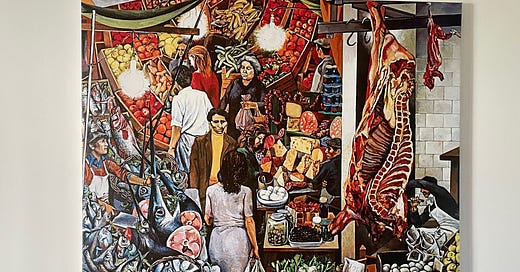This is a photo of a picture that hangs on the wall above my dining table. It was painted by the Italian artist Renato Guttuso in 1974 and is called La Vucirria, after the marketplace in Palermo, Sicily. I love this picture, because it is portrays the ordinary and the richness of daily life: human interaction, menacing rivalry, shopping, and of course food.
Italy is a country where the food culture remains sacrosanct, despite scheming corporate moves to control and distort culinary traditions. Even the government is alarmed and has moved to head off threats to the nation’s revered, food-loving identity. It recently approved a bill to ban cell-based laboratory food, and has plans to place restrictions on the labelling of fake meat products, prohibiting terms such as “tofu steak” and “vegan mortadella”. The government’s stated aim is to “protect national livestock heritage”.
Sicily is an island in the middle of the Mediterranean. Guttuso’s painting depicts typical Mediterranean foods: fish, meat, eggs, olives, fruits and vegetables. You can see two big mortadella hams in the background of the image, with their distinctive chunks of fat embedded in the cured pork. There’s a huge beef carcass and what looks like a skinned rabbit hanging next to it. In front of the mortadella is a variety of large cheeses. Cheese, in all its countless, glorious incarnations is a major feature in the Italian diet and indeed across the whole Mediterranean region.
What you see here is the real Mediterranean diet, not the fictitious one that is often portrayed as a paragon of health and longevity. The recently constructed “Mediterranean diet” that you read about everywhere is the subject of many studies, where it magically outperforms all other diets and provides the rationale for the health and longevity of the peoples of the region. That’s quite an achievement, for something that doesn’t exist. Below is a guide to how you should eat, according to the diet’s enthusiasts.
Image
To be fair, much of it is fairly accurate. Vegetables and fruits are significant players in the real Med diet. So too are fish and olive oil. But red meat, including processed red meat, is central to the traditions of the region, and eaten abundantly. So too is cheese. The Spanish love their cured meats, and happily export much of it to us. Chorizo, jamón serrano, jamón de Teruel, jamón ibérico, botillo del bierzo, are among the most popular, but there are many more. As there are in Italy, where you’ll find, in addition to mortadella, prosciutto crudo (raw ham), bresaola (cured beef), salami, speck (lightly smoked ham) and of course lardo. And you don’t get more lardy than lardo, slabs of pure pig fat cured with a few herbs, spices and salt.
If you were to follow the official Mediterranean diet, you would limit or avoid red meat completely. In fact, as you can see from the above guide, you should consume more red wine than red meat, advice that some might readily embrace on the promise of better life expectancy.
What you won’t find readily available in the real Med diet is whole grain anything – bread, risotto and pasta remain resolutely refined. You might get laughed out of town if you asked for wholemeal pasta in a local shop.
One of the many proclaimed benefits of the made-up Med diet is that it can extend healthy life expectancy. Red meat, on the other hand, could shorten your life. That’s the theory, but is it true?
An international group of scientists set out to answer that question. Using data obtained from United Nations agencies, they examined the association between meat intake, carbohydrate intake, and life expectancy across 175 countries and territories.
Published in 2022 in the International Journal of General Medicine, the findings of the study were that worldwide, meat intake (but not carbohydrate) was positively and significantly correlated with longer life expectancy.
“Our statistical analysis results indicate that countries with the greater meat intake have greater life expectancy and lower child mortality.”
It’s easy enough to list the many nutrients in meat that in combination promote optimal health: vitamins, minerals, fatty acids, choline and protein. But there is one distinctive nutrient that stands out from the crowd: taurine.
Found naturally in meat and fish but virtually non-existent in plants, taurine is an amino acid that the body can make, but only in small quantities, making it semi-essential.
Keep reading with a 7-day free trial
Subscribe to Your Nutritionist Recommends to keep reading this post and get 7 days of free access to the full post archives.





